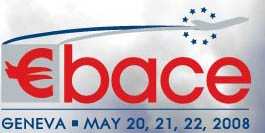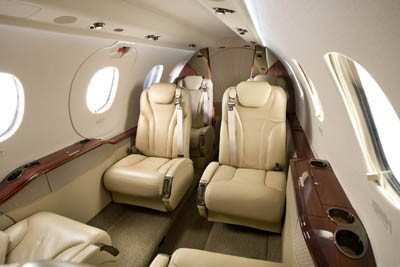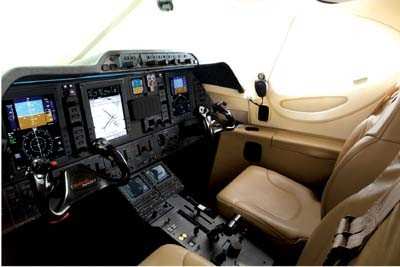Billed As World's Largest, Best Performing, Most Advanced
Single Pilot Bizjet
In appropriate fashion, Monday's premier of the 8th Annual
European Business Aviation Convention & Exhibition was
accompanied by a Premier of another sort. Hawker Beechcraft
Corporation launched the newest member of its ever-growing family
of business jets -- the new Beechcraft Premier II light jet.

Evolving from the successful Premier IA, the Premier II will
feature higher cruise speeds, a 20 percent longer range with four
passengers and an increased payload... while still offering the
largest cabin and most technologically advanced single-pilot
business jet in the world.
 "For 75 years, our
company has been on the forefront of private and business jet
aviation," said Jim Schuster, Hawker Beechcraft chairman and CEO.
"The Beechcraft Premier II will redefine the light jet market and
take it to a new level in meeting customer expectations. With its
unmatched performance and efficiency, impressively spacious cabin
and advanced technology, the Premier II is a natural choice for
business and private travelers who want to travel in comfort and
get to their destination quickly."
"For 75 years, our
company has been on the forefront of private and business jet
aviation," said Jim Schuster, Hawker Beechcraft chairman and CEO.
"The Beechcraft Premier II will redefine the light jet market and
take it to a new level in meeting customer expectations. With its
unmatched performance and efficiency, impressively spacious cabin
and advanced technology, the Premier II is a natural choice for
business and private travelers who want to travel in comfort and
get to their destination quickly."
The Premier II will be a twin turbofan, swept wing, light jet
aircraft featuring a high-strength, state-of-the-art all-composite
fuselage that allows for a medium-jet sized cabin at light jet
costs. Featuring luxurious and comfortable standard seating for up
to six passengers and their baggage, the Premier II will deliver
more people to more locations, more efficiently and in more comfort
than any other light jet.
At the heart of these major aircraft advancements will be a pair
of FJ44-3AP turbofan engines, the newest member of the Williams
International engine family. The efficient turbofans will produce
6,000 pounds of combined thrust, an increase of more than 23
percent from the Premier IA. Combined with new elliptical winglets,
the new-generation engines will allow the Premier II to climb
higher to an unrestricted, chart-topping maximum cruising altitude
of 45,000 feet and fly farther -- a 1,500 nm (2,778 km) mission
with one pilot and four passengers.

The 4,000-foot operating ceiling boost also puts passengers well
above most traffic and weather, allowing them to enjoy the
smoothest ride and arrive at their destination faster. The higher
thrust engines will also improve high/hot take-off operations and
increase maximum cruise speed to 465 knots (861 km/hr) at typical
cruise altitudes.
"The Beechcraft Premier IA is the fastest large-cabin,
single-pilot business jet in production today, and the Premier II
will be even better. Our program objective was all about improving
the performance of our exceptionally successful Premier IA," said
Brad Hatt, president, Commercial Aircraft. "The Premier II takes
everything that operators love about the Premier IA and improves
upon it to create an aircraft that will deliver the performance and
capabilities of a much larger jet while providing the economy and
efficiency of a light jet. The result is an aircraft that can fly
further, faster and higher than ever before."
Inside the Premier II cockpit, pilots will face an upgraded
Rockwell Collins Pro Line 21 panel layout, incorporating a new
3-in-1 Electronic Standby Instrument System (ESIS), FADEC control
switches, VHF Comm ground switch and avionics integration of the
standby COMM/NAV controller. All these changes are designed to
reduce the workload for a single pilot.

Composite, elliptical-shaped winglets will be installed to
enhance aerodynamic performance. The winglets offer reduced drag,
and an increased effective wingspan without actually lengthening
the wings, enabling the Premier II to fly farther than its
predecessor. The custom designed winglets were sized to provide
distinct performance improvements while not impacting airframe
inspection schedules.
The improved capability is also largely due to the Premier
II’s certification in accordance with 14 CFR Part 23 Commuter
Category thru Amendment 23-57, which will include new engines
specified in compliance with the environmental aircraft pollution
standards.
First flight of the aircraft is scheduled for April 2009 with
FAA Certification planned for Q2 2010. European Aviation Safety
Authority (EASA) certification is expected in Q4 2010.
 ANN's Daily Aero-Linx (04.15.24)
ANN's Daily Aero-Linx (04.15.24) Classic Aero-TV: 'No Other Options' -- The Israeli Air Force's Danny Shapira
Classic Aero-TV: 'No Other Options' -- The Israeli Air Force's Danny Shapira Aero-News: Quote of the Day (04.15.24)
Aero-News: Quote of the Day (04.15.24) Airborne 04.16.24: RV Update, Affordable Flying Expo, Diamond Lil
Airborne 04.16.24: RV Update, Affordable Flying Expo, Diamond Lil ANN's Daily Aero-Term (04.16.24): Chart Supplement US
ANN's Daily Aero-Term (04.16.24): Chart Supplement US






